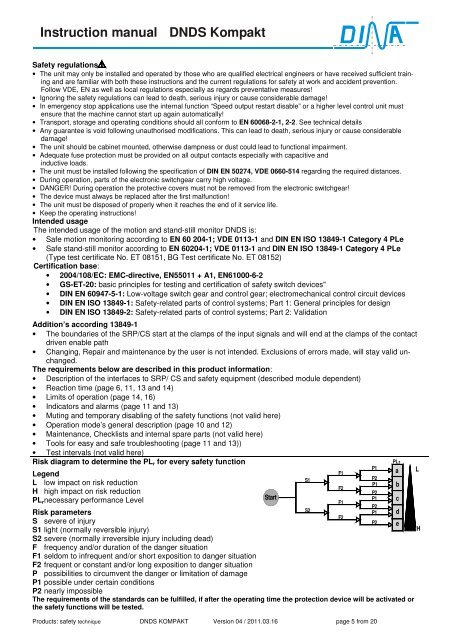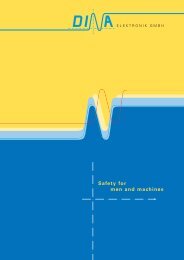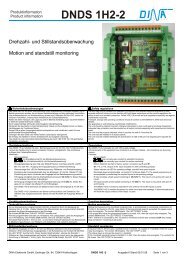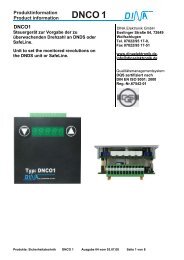Instruction manual DNDS Kompakt - Dinaelektronik.com
Instruction manual DNDS Kompakt - Dinaelektronik.com
Instruction manual DNDS Kompakt - Dinaelektronik.com
Create successful ePaper yourself
Turn your PDF publications into a flip-book with our unique Google optimized e-Paper software.
<strong>Instruction</strong> <strong>manual</strong> <strong>DNDS</strong> <strong>Kompakt</strong><br />
Safety regulations<br />
• The unit may only be installed and operated by those who are qualified electrical engineers or have received sufficient training<br />
and are familiar with both these instructions and the current regulations for safety at work and accident prevention.<br />
Follow VDE, EN as well as local regulations especially as regards preventative measures!<br />
• Ignoring the safety regulations can lead to death, serious injury or cause considerable damage!<br />
• In emergency stop applications use the internal function “Speed output restart disable” or a higher level control unit must<br />
ensure that the machine cannot start up again automatically!<br />
• Transport, storage and operating conditions should all conform to EN 60068-2-1, 2-2. See technical details<br />
• Any guarantee is void following unauthorised modifications. This can lead to death, serious injury or cause considerable<br />
damage!<br />
• The unit should be cabinet mounted, otherwise dampness or dust could lead to functional impairment.<br />
• Adequate fuse protection must be provided on all output contacts especially with capacitive and<br />
inductive loads.<br />
• The unit must be installed following the specification of DIN EN 50274, VDE 0660-514 regarding the required distances.<br />
• During operation, parts of the electronic switchgear carry high voltage.<br />
• DANGER! During operation the protective covers must not be removed from the electronic switchgear!<br />
• The device must always be replaced after the first malfunction!<br />
• The unit must be disposed of properly when it reaches the end of it service life.<br />
• Keep the operating instructions!<br />
Intended usage<br />
The intended usage of the motion and stand-still monitor <strong>DNDS</strong> is:<br />
• Safe motion monitoring according to EN 60 204-1; VDE 0113-1 and DIN EN ISO 13849-1 Category 4 PLe<br />
• Safe stand-still monitor according to EN 60204-1; VDE 0113-1 and DIN EN ISO 13849-1 Category 4 PLe<br />
(Type test certificate No. ET 08151, BG Test certificate No. ET 08152)<br />
Certification base:<br />
• 2004/108/EC: EMC-directive, EN55011 + A1, EN61000-6-2<br />
• GS-ET-20: basic principles for testing and certification of safety switch devices"<br />
• DIN EN 60947-5-1: Low-voltage switch gear and control gear; electromechanical control circuit devices<br />
• DIN EN ISO 13849-1: Safety-related parts of control systems; Part 1: General principles for design<br />
• DIN EN ISO 13849-2: Safety-related parts of control systems; Part 2: Validation<br />
Addition’s according 13849-1<br />
• The boundaries of the SRP/CS start at the clamps of the input signals and will end at the clamps of the contact<br />
driven enable path<br />
• Changing, Repair and maintenance by the user is not intended. Exclusions of errors made, will stay valid unchanged.<br />
The requirements below are described in this product information:<br />
• Description of the interfaces to SRP/ CS and safety equipment (described module dependent)<br />
• Reaction time (page 6, 11, 13 and 14)<br />
• Limits of operation (page 14, 16)<br />
• Indicators and alarms (page 11 and 13)<br />
• Muting and temporary disabling of the safety functions (not valid here)<br />
• Operation mode’s general description (page 10 and 12)<br />
• Maintenance, Checklists and internal spare parts (not valid here)<br />
• Tools for easy and safe troubleshooting (page 11 and 13))<br />
• Test intervals (not valid here)<br />
Risk diagram to determine the PLr for every safety function<br />
PLr<br />
Legend<br />
L low impact on risk reduction<br />
H high impact on risk reduction<br />
PLrnecessary performance Level<br />
Risk parameters<br />
S severe of injury<br />
S1 light (normally reversible injury)<br />
S2 severe (normally irreversible injury including dead)<br />
F frequency and/or duration of the danger situation<br />
F1 seldom to infrequent and/or short exposition to danger situation<br />
F2 frequent or constant and/or long exposition to danger situation<br />
P possibilities to circumvent the danger or limitation of damage<br />
P1 possible under certain conditions<br />
P2 nearly impossible<br />
The requirements of the standards can be fulfilled, if after the operating time the protection device will be activated or<br />
the safety functions will be tested.<br />
Products: safety technique <strong>DNDS</strong> KOMPAKT Version 04 / 2011.03.16 page 5 from 20<br />
Start<br />
S1<br />
S2<br />
F1<br />
F2<br />
F1<br />
F2<br />
P1<br />
P2<br />
P1<br />
P2<br />
P1<br />
P2<br />
P1<br />
P2<br />
a<br />
b<br />
c<br />
d<br />
e<br />
L<br />
H









